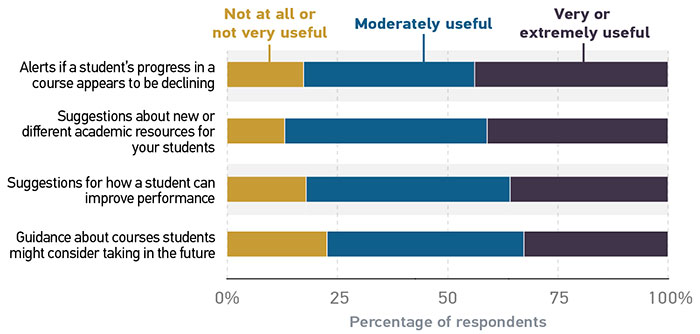Faculty Who Use Online Student Success Tools Value Them
Academic goal-setting and planning has been identified as a high-impact practice to increase community college student engagement, so it makes sense that faculty should have the support and opportunity to use all strategies available to engage with their students regarding their academic plans.1 And for many two-year institutions, the adoption of online student success tools has become an important part of that engagement plan. When we asked faculty what they thought of online student success tools (e.g., those that suggest new academic resources, and early alerts for declining student performance), the majority among those who had used each of them said they were at least moderately useful (between 77% and 87%) (figure 6). Tools that provide suggestions about new or different academic resources for students (e.g., tutoring, skills-building opportunities) came in at the top, with 87% of respondents rating these at least moderately useful.

The resources that were used the least include those that offer guidance about courses students might consider taking in the future (38% of faculty did not use) and those that provide suggestions for how a student can improve performance (25% did not use). The large percentage of faculty who haven't used tools that offer guidance about courses students might consider taking is concerning for faculty who serve in advising roles. While some faculty might not have these responsibilities, others might lack the skills to implement these resources, or they might not have access to them at all. Tools that guide students in their course planning can be especially important to community college students, who take, on average, about four years to get a degree and, in many cases, earn considerably more credits than needed for their degree.2 Our findings are particularly encouraging when we consider the students who find these kinds of resources the most helpful. In our 2019 study of community college students, significantly more minority than white students rated tools such as early-alert systems and tools that suggest how to improve their performance in a course as very or extremely useful.3 Since two-year and AA degree-granting colleges serve more underrepresented students, faculty who use these systems have the opportunity to support these groups in meeting their goals, whether that is to complete a two-year degree or a professional credential or transfer to a four-year institution. To maximize these benefits, IT departments can partner with student services and other instructional units to increase awareness of these online advising resources and train faculty on best practices.
Notes
-
Center for Community College Student Engagement, A Matter of Degrees: Engaging Practices, Engaging Students (High-Impact Practices for Community College Student Engagement) (Austin, TX: The University of Texas at Austin, Community College Leadership Program, 2013).
↩︎ -
Complete College America, "Data Dashboard: Common College Completion Metrics"; Jon Marcus, "Some Colleges Start to Confront a Surprising Reason Students Fail: Too Many Choices," The Hechinger Report, February 7, 2020.
↩︎ -
Gierdowski, ECAR Study of Community College Students and Information Technology, 2019.
↩︎